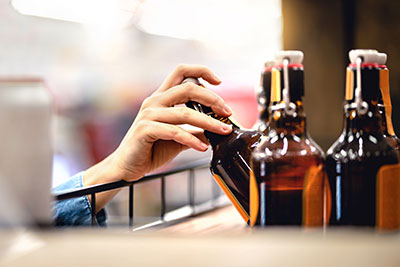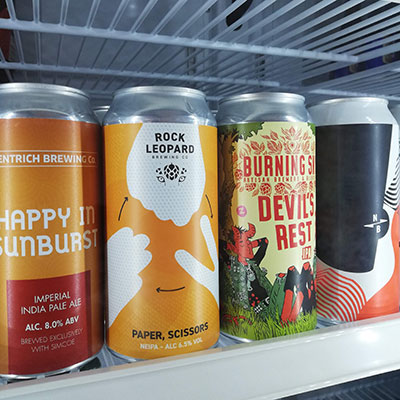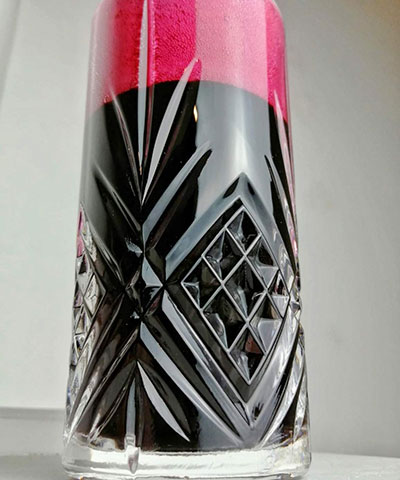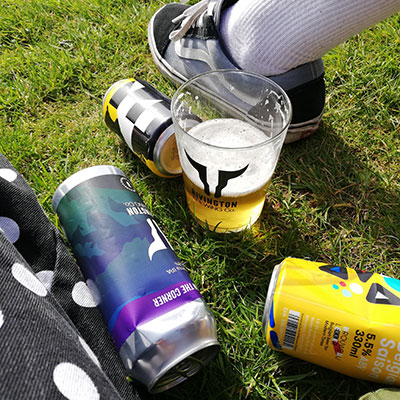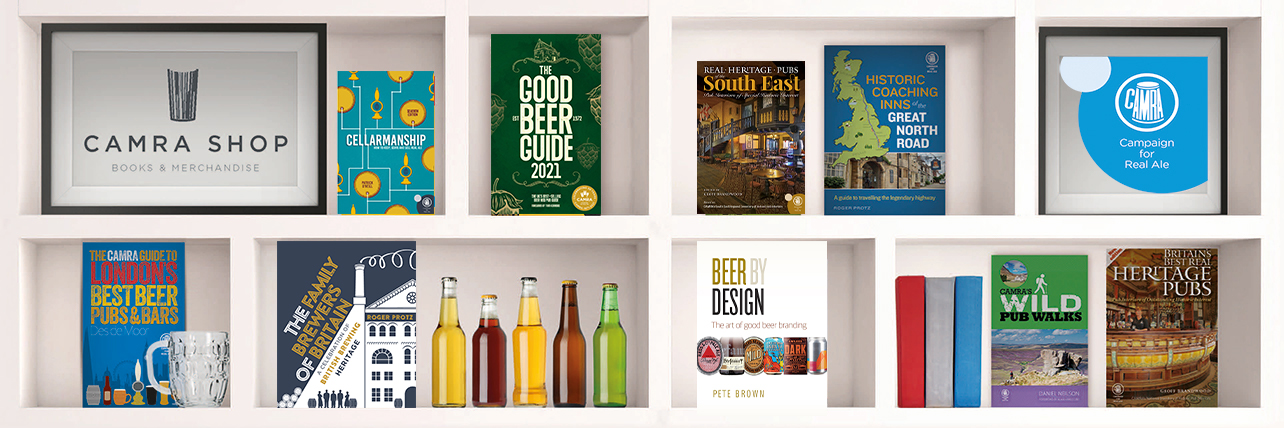Learn & Discover
Learn & Discover
Storing and serving
Get the best out of your beer at home
There’s nothing like drinking beer at the pub, is there? Expertly cellared, perfectly poured; a great pint is a truly beautiful thing. Over lockdown, however, we all had to adapt our drinking habits, and since many of us have been drinking beer at home more often. As we move safely back into the pub, enjoying a beer or two at home has become less of a necessity. There are times though, when a beer on the sofa or in the garden with friends is ideal. Read on for an introductory guide to storing and serving beer at home.
Storing and serving
Get the best out of your beer at home
There’s nothing like drinking beer at the pub, is there? Expertly cellared, perfectly poured; a great pint is a truly beautiful thing. Over lockdown, however, we all had to adapt our drinking habits, and since many of us have been drinking beer at home more often. As we move safely back into the pub, enjoying a beer or two at home has become less of a necessity. There are times though, when a beer on the sofa or in the garden with friends is ideal. Read on for an introductory guide to storing and serving beer at home.
Katie Mather
A beer blogger-turned-food and drink writer. Co-owner of Corto, a neighbourhood bar in Clitheroe. Loves pubs.
Ordering Your Beer
Serving great beer at home starts when you’re buying it.
There are hundreds of ways to buy take-out beer, from your local bottle shop or direct from your pub, from your favourite off-licence or supermarket, and directly from breweries.
When you choose your beer, if you can, make sure to check the BBE date on the can, bottle or mini-cask/mini-keg. The fresher your beer, the better it will taste at home.
Also, remember that beer will taste much better if it has been stored in a refrigerated display unit or a cold store. Ambient shelves, such as those in a corner shop, are fine for the short-term, but your beer’s delicious aromas and flavours will stay fresher for longer stored at a cooler temperature.
Ordering Your Beer
Serving great beer at home starts when you’re buying it.
There are hundreds of ways to buy take-out beer, from your local bottle shop or direct from your pub, from your favourite off-licence or supermarket, and directly from breweries.
When you choose your beer, if you can, make sure to check the BBE date on the can, bottle or mini-cask/mini-keg. The fresher your beer, the better it will taste at home.
Also, remember that beer will taste much better if it has been stored in a refrigerated display unit or a cold store. Ambient shelves, such as those in a corner shop, are fine for the short-term, but your beer’s delicious aromas and flavours will stay fresher for longer stored at a cooler temperature.

Storing Your Beer At Home
Just like the shops and breweries you buy your beer from, try whenever possible to store your beer at a cooler temperature at home.
Beer fares better in cool, dark places where the temperature remains constant, like cellars and insulated garages. Your under-stairs cupboard could be ideal!
Using A Dedicated Beer Fridge
If you have a dedicated fridge, this is probably the most ideal way to store beer in your home, especially beers with a lot of hops in, like IPAs, DIPAs and Pale Ales, whose flavours and aromas degrade quickly in unsuitable conditions.
Keeping the fridge at a constant temperature of around 5°C, and avoiding opening the door too often, will ensure your beer is kept in peak condition ready for drinking.
If you do not have a beer fridge, join the club! They aren’t essential purchases by any means. Ensuring your beer is kept at a cool, constant temperature away from strong light is the most important thing.
Storing Your Beer At Home
Just like the shops and breweries you buy your beer from, try whenever possible to store your beer at a cooler temperature at home.
Beer fares better in cool, dark places where the temperature remains constant, like cellars and insulated garages. Your under-stairs cupboard could be ideal!
Using A Dedicated Beer Fridge
If you have a dedicated fridge, this is probably the most ideal way to store beer in your home, especially beers with a lot of hops in, like IPAs, DIPAs and Pale Ales, whose flavours and aromas degrade quickly in unsuitable conditions.
Keeping the fridge at a constant temperature of around 5°C, and avoiding opening the door too often, will ensure your beer is kept in peak condition ready for drinking.
If you do not have a beer fridge, join the club! They aren’t essential purchases by any means. Ensuring your beer is kept at a cool, constant temperature away from strong light is the most important thing.
Serving Your Beer At The Correct Temperature
The best way to drink beer at home is to serve it at the correct temperature. This depends on the type of beer you want to serve.
Light Lagers, Helles and Pils: 4°C—6°C
Pale Ales, IPAs, Porters and Stouts: 7°C—10°C
Belgian Beers, Sours, Barley Wines, High ABV Stouts, Bocks: 10+°C
Note: The average home refrigerator is set to around 4 °C
You can use a thermometer if you like, but it does take away some of the spontaneous relaxation and enjoyment of cracking open a beer!
This guide is intended more as a general reference — use it to help you remember that you need to take your beer out of the fridge to warm up a little bit, or that you might prefer to chill your cans for 15 minutes or so after retrieving them from the spare room.
Guidance on serving temperature can often be found on the bottle, can or direct from the brewer. Remember, beer will warm up to your preferred temperature outside of the fridge.
Serving Your Beer At The Correct Temperature
The best way to drink beer at home is to serve it at the correct temperature. This depends on the type of beer you want to serve.
Light Lagers, Helles and Pils: 4°C—6°C
Pale Ales, IPAs, Porters and Stouts: 7°C—10°C
Belgian Beers, Sours, Barley Wines, High ABV Stouts, Bocks: 10+°C
Note: The average home refrigerator is set to around 4 °C
You can use a thermometer if you like, but it does take away some of the spontaneous relaxation and enjoyment of cracking open a beer!
This guide is intended more as a general reference — use it to help you remember that you need to take your beer out of the fridge to warm up a little bit, or that you might prefer to chill your cans for 15 minutes or so after retrieving them from the spare room.
Guidance on serving temperature can often be found on the bottle, can or direct from the brewer. Remember: beer will warm up to your preferred temperature outside of the fridge.
Glassware
Glassware is the catch-all term for the glasses you use to drink beer from. Bombshell alert: you don’t need to have loads of types of glassware in your home to enjoy great beer.
Some people really enjoy collecting glassware, and that’s cool! But for a lot of people, having one or two styles suits the job just fine. We recommend having your favourite style of pint glass to hand (perhaps one from a CAMRA beer festival?) and a smaller stemmed glass for beers you’d like to keep away from the warming effects of your hands once you’ve brought it to the right temperature.
If you want to get nerdy, the shape of a glass has been proven to enhance or minimise the aromas within.
Bowl shaped glassware such as snifters are great for richly aromatic beers like barley wine, stouts and porters, and Teku glasses and rounded Tumbler shapes are great for hoppy IPAs and pale ales.
Whichever style you choose, your glassware has to be sparklingly clean. This avoids contamination with cleaning products and removes dish soap residue, which can knock out your beer’s foamy head.
If you don’t have a dishwasher, you can do this by giving your glasses an extra rinse in hot water after washing them, and then drying with a cotton tea towel.
All that’s left now is for you to enjoy your beer!
Glassware
Glassware is the catch-all term for the glasses you use to drink beer from. Bombshell alert: you don’t need to have loads of types of glassware in your home to enjoy great beer.
Some people really enjoy collecting glassware, and that’s cool! But for a lot of people, having one or two styles suits the job just fine. We recommend having your favourite style of pint glass to hand (perhaps one from a CAMRA beer festival?) and a smaller stemmed glass for beers you’d like to keep away from the warming effects of your hands once you’ve brought it to the right temperature.
If you want to get nerdy, the shape of a glass has been proven to enhance or minimise the aromas within.
Bowl shaped glassware such as snifters are great for richly aromatic beers like barley wine, stouts and porters, and Teku glasses and rounded Tumbler shapes are great for hoppy IPAs and pale ales.
Whichever style you choose, your glassware has to be sparklingly clean. This avoids contamination with cleaning products and removes dish soap residue, which can knock out your beer’s foamy head.
If you don’t have a dishwasher, you can do this by giving your glasses an extra rinse in hot water after washing them, and then drying with a cotton tea towel.
All that’s left now is for you to enjoy your beer!


